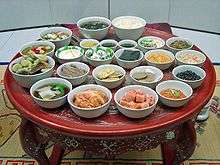Suksilgwa
| Type | Hangwa |
|---|---|
| Place of origin | Korea |
| Main ingredients | Fruit, ginger or nuts, honey or yeot |
|
| |
| Suksilgwa | |
| Hangul | 숙실과 |
|---|---|
| Hanja | 熟實果 |
| Revised Romanization | suksilgwa |
| McCune–Reischauer | suksilkwa |
Suksilgwa is a variety of hangwa, Korean traditional confectionery, made by boiling various fruits, ginger or nuts in water and then reformed into their original fruit-shape or other shapes. The ingredients are sweetened or coated with honey or yeot. Suksilgwa literally means "cooked fruits" in Korean to refer to the opposite term of saenggwa (생과 fresh fruits).[1] It has been used for largely special occasions such as janch (잔치; feast or banquet), or jesasang (제사상, 祭祀床, ceremonial table setting for jesa, ancestor worship). In order to make the dish, fresh and good quality fruits or nuts are necessary and chestnuts, pine nuts are commonly used. It was consumed in yangban or royal families during the Joseon Dynasty and the cooking process required a lot of elaboration. Suksilgwa is usually served with two or three kinds in one dish.[2]
Varieties
Suksilgwa is divided into two types such as ran (란 卵), and cho (초 炒) by the cooking method. Each of the terms is affixed to the main ingredient. The ran type of suksilgwa is made by meshing boiled ingredients and mixing them with honey. The mixture is shaped to its original fruit shape. On the other hand, cho type is pan-fried without the meshing process.[2]
- Yullan (율란 栗卵), meshed and boiled chestnut mixed with honey
- Joran (조란 棗卵), meshed and boiled jujube mixed with honey
- Gangran (강란, 생란 薑卵), made by meshing ginger
- Yulcho or bamcho (율초, 밤초 栗炒), made by pan-fried chestnuts
- Daechucho (대추초), made by pan-fried jujube
See also
References
External links
- General information about Korean desserts
- (Korean) Information about Hangwa
- (Korean) Information about Hangwa
 |
| This article is part of a series on |
| Korean cuisine 한국 요리 조선 료리 |
|---|
|
Staples |
|
Condiments |
|
|
